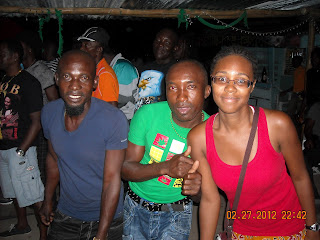As I mentioned earlier, the funeral lasted 3 or 4 months. Since
the graanman was in power for over 40 years and widely respected throughout the
country, the community needed a long time to say goodbye. The grave took a long
time to dig because it was the size of a house. Four or five days a week, men
would go to the grave site across the river. I watched the boats leave in the
morning and return in the evening. No one was allowed to stand in the water
while the grave digger’s boat was traveling to the grave site. Women would
bring them lunch.
Here is a photo of the women pounding rice together for the
funeral.
When the gravedigger’s boat returned home, women stood in
the river and splashed water. Everyone
else stood on the pier and watched as the boat drove in proud circles. Someone
played drums, and someone dressed up. The kids loved it – they ran towards the
water, then ran away and screamed when the women splashed them. (Then the kids tripped over each other and
got hurt). The place where the gravedigger’s boat returned each day was a
temporary dance floor constructed just for the funeral. Several gorgeous hand-woven
pangies hung from the ceiling. This area was in the village, rather than near
the gravesite.
The casket had its own room facing the dance floor so that
we could see it while we danced. The casket was beautiful. It was wrapped in
dozens of pangies (traditional maroon cloth), and covered with a Surinamese
flag. It was about 5 tall and 6 or 7 feet wide. A photo of the graanman was
placed above the casket. The room had space for the graanman’s wives to sleep
behind their deceased husband.
Later, several men gave speeches to the deceased graanman.
They updated him on their progress in digging the grave. Photos of the casket
and funeral speeches were not allowed, so I have no pictures of this.




